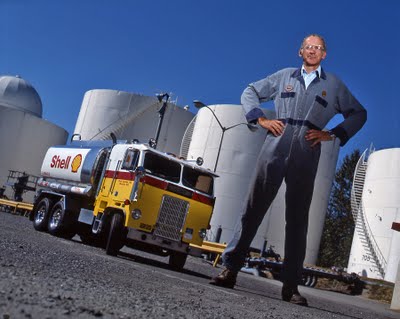The Littlest Truck
Tuesday, September 08, 2009

Some people think that the life of a freelance photographer is exciting. After all, the photographer meets and photographs celebrities, politicians and other important people. And when it’s not important people it is beautiful undraped women in the studio or in exotic locations.
Does anybody ever think of freelancers shooting trucks, trains, commercial airplanes, train crews, and the retirement/roasts for the executives of Great Canadian Railroad companies? I did a lot of that for almost 25 years for CP Limited, Air Canada, Shell and many other companies. I worked on brochures for every university and technical institute of the Lower Mainland. Annual reports for many logging and energy companies took me to all parts of BC and several other provinces. In fact one annual report made me so much money that on an impulse (one I will regret for the rest of my life) I purchased a Maserati.
This kind of photography took me to the tops of tall buildings. I climbed bridges and other dangerous structures and I never thought of the consequences of a misstep. I was stupidly young. I took pictures in the Yukon in January at 3500 feet where the minus 55 degrees Celsius froze the metal zipper of my parka to my mouth. Fortunately I never had the ambition of being in a war zone and was never attracted to the thrill that others might have felt at being shot at.
I often wondered how some of the Hell’s Angels earned their keep to buy their expensive hogs. For the CPR I often took pictures of scalers who were engineers that precipitated small avalanches in gullies and banks near railroad tracks. This made it safer for trains. I also photographed the last caboose before it was retired. When I photographed train crews working on track repair and maintenance I ran into very large men who would turn their face when I pointed my camera at them. It was only after talking to their supervisor and clearing it with him as to why I was taking the photographs (the CPR newsletter) that some of the workers remained and posed while the bulk of them made a quick exit. Watching my puzzled look the supervisor explained the extracurricular activities of those that had left the scene.
My finest moment happened in the late 80s at the Siska Bridge crossing over the Fraser River near Lytton, British Columbia. At the Siska Bridge the folks of the CPR went from one side of the Fraser to the other while those of the CN went on the opposite. It was a location that featured mountains, forests, a river, a canyon and two bridges. It was a microcosm, a sort of compact version of “Beautiful British Columbia”. The day in question, sometime in July was the hottest day of the year. The hottest day of the year in those parts (40 degrees Celsius) was always the hottest place in Canada. I positioned my Mamiya RB-67 on a tripod. I had a walkie-talkie. The CP train came. It was a carg train loaded with brand new Toyotas, Nissans and Mazdas. When the Toyotas began to cross the bridge I yelled into my transceiver, “Stop now!” The train stopped and I snapped a few pictures of the Toyotas with the backdrop of the Siska interchange. I yelled, “Move,” until I asked the engineer to stop for the Nissans and then for the Mazdas.
How many people can boast of being able to stop a mile long train, not only once but three times? That was indeed my finest moment. The folks of the CPR after compensating me generously for my efforts made large prints of my pictures which were given to Japanese car executives.
This industrial photograph for a Shell Canada newsletter was lots of fun to take. The truck was only about 6 ft long and the gentleman in the picture drove it (sitting inside the tanker side of the truck) to the location that I picked. It has always been one of my favourites.






